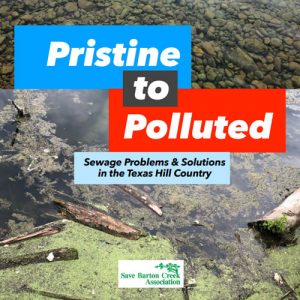Pristine to Polluted: Sewage Problems & Solutions in the Texas Hill Country

The Hill Country has always been one of the most treasured parts of our state, both by the residents who live there and by the Texans who visit it for recreation. The region’s allure lies not just in its unique terrain, but in its waterways. From the Colorado River to the San Antonio River, from Cypress Creek to Cibolo Creek, from Barton Springs to Comal Springs, these water bodies are some of the Hill Country’s most popular features. In addition, the region is the location of two major underground reservoirs — the Edwards Aquifers, which supplies drinking water to 1.7 million people in the San Antonio area, and the Trinity Aquifer, which supplies water to many other Hill Country residents.
However, the Hill Country’s streams and aquifers are facing a growing threat: sewage pollution. Some people may think that the treated sewage that comes out of a wastewater treatment plant is clean water. But only some pollutants are removed during treatment, while others are left in. Because the Hill Country’s rivers and creeks often have low or sporadic flow, treated wastewater often makes up a large part of the stream volume below a treatment plant. This can harm both the streams, and the aquifers they replenish.
Dumping treated sewage into streams is regulated by direct discharge permits issued by the Texas Commission on Environmental Quality (TCEQ). Wastewater discharge caused fewer problems when the Hill County was lightly populated. But the number of people living in the region’s 17 counties has been steadily increasing, from approximately 800,000 in 1950 to 3.4 million in 2015. By 2050 the area’s population is projected to double, to 6.8 million. A larger population means more wastewater. Several new or expanded permits have been approved in recent years — some for direct discharge (dumping treated wastewater into streams and lakes), others for land application (irrigating treated wastewater on fields). TCEQ is currently considering applications for a new discharge permit on a tributary of Barton Creek below Austin, an expanded discharge permit on the Blanco River, and a land application permit on Honey Creek near Guadalupe River State Park.
For our Hill Country Sewage Scorecard, we examined pollutant monitoring data that was self-reported by the 48 municipal sewage treatment plants with discharge permits in the region’s 17 counties. We found that during the past three-and-a-half years, 39 facilities exceeded at least one of the pollutant limits set by TCEQ in their operating permits. In other words, 81 percent of Hill Country sewage plants dumped something into a stream that wasn’t allowed by their permit at least once since 2017.
The most common failures were for oxygen depletion and excess suspended solids (both of which can harm aquatic life), and E. coli bacteria (which can harm people). The key measurement used for this report was the total number of days with reported pollutant exceedances from January 2017 to 2020. During this period, 6 plants had 1-50 days with exceedances, 15 plants had 51-500 days, and 6 plants had more than 500 days. Only 6 plants had no exceedances.
And this was just for the sewage pollution that’s regulated and reported. Because most discharge permits only contain monthly average limits for pollutants, some plants may have had high daily levels of pollutants that they didn’t have to report.
Plus, only some pollutants are removed during sewage treatment, while others remain. Two of those pollutants, phosphorus and nitrogen, do the same thing in the water that they do on land: they help plants grow. Dumping inadequately treated sewage into streams can lead to large growths of algae. Known as blooms, these growths can cause oxygen depletion, which harms fish and other aquatic life. Some forms of algae also produce toxins that can poison people and their pets. Algae has recently blanketed central Texas streams at locations below sewage facilities, including plants in Blanco and Liberty Hill.
Because existing plants are already problem-plagued, it’s essential that new permits should be issued sparingly and with tight restrictions. Recommendations for policy changes and other actions are included in Chapter 5 of this report. Fewer discharge permits should be issued, pollutant limits should be lowered, and all wastewater permits should be required to use better treatment methods. In lower-density developments, modern septic tanks and community-scale systems can provide decentralized wastewater treatment.
In higher-density developments, dispersing treated sewage into the soil may be a better alternative than dumping it into streams. Treated wastewater is already being used to irrigate parks, golf courses, farms, and undeveloped fields in the Hill Country. All new developments should be designed to reuse treated wastewater for non-potable purposes such as watering lawns and flushing toilets. Reuse is key to implementing the One Water approach, which manages natural water, stormwater, and wastewater as different forms of the same resource in an integrated approach.
The Hill Country’s population won’t stop growing, which is why we need to prepare now for future growth. Better sewage treatment methods and more protective permits mean that wastewater can be transformed from a problem that pollutes our rivers and streams into a resource that helps conserve our best water for more important uses.